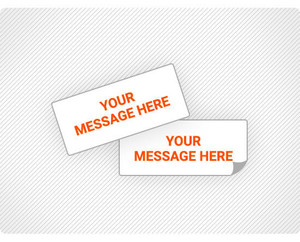
HazCom Labeling
Keep your facility GHS and OSHA compliant.
Businesses must comply with OSHA's Hazard Communication (HazCom) Standard for educating and informing workers about hazardous chemicals in the workplace. Additionally, HazCom is aligned the United Nations' Globally Harmonized System of Classification and Labeling of Chemicals (GHS). This means employers must follow new regulations for the information included on labels, the sections of safety data sheets, and more.

MSDS Labels
Quickly inform users of the hazard level associated with a certain chemical.
The Hazard Communication Standard (HCS) states that chemical manufacturers, distributors, and importers are required to provide Material Safety Data Sheets (MSDS), for each hazardous chemical. Though these sheets are extremely detailed, sometimes there isn't enough time for them to be read. Informative labels that describe health effects of exposure, level of risk involved with chemical, and emergency procedures in event of exposure are so crucial to a facility’s safety.

GHS Labeling
Keep your labels compliant and workers safe.
Facilities that use hazardous chemicals need labels that reflect the Globally Harmonized System (GHS) standard for chemical labeling, which was adopted by OSHA and become mandatory in the U.S. in 2016. Our GHS labels were designed to endure water, chemicals, abrasions, and fading

HMIS Labels
Help workers learn how to navigate the Hazardous Material Identification System (HMIS).
Hazard communication is essential to the safety of any facility that uses or stores hazardous chemicals. In order to make sure your workers are informed, safe, and protected, a Hazardous Materials Identification System (HMIS) is key. Using both GHS and OSHA HazCom standards, HMIS is the numerical hazard rating educational tool used to keep workers safe and businesses compliant.

Toxic Chemicals Signs
Inform workers of the dangerous toxics and instruct them on how to avoid injury.
Visual communication can reduce the risk of accidents and help workers stay safe. Safety one of the pillars of Lean manufacturing; it’s important to take actions that reduce the risk of accidents or injury. Remember: a safe facility is a productive facility.

GHS Labels
GHS labels for the hazardous chemical containers in your facility.
Choose from a family of LabelTac® printers and create as many GHS labels as you need. A simple solution for making new HazCom-compliant labels in house and on demand. Included software provides helpful label creation templates.

GHS Label Printers
Print custom GHS labels on demand.
Updating your HazCom labels so they comply with the Globally Harmonized System of Classification and Labeling of Chemicals (GHS) Standard can take a lot of time and effort. For facilities that print large numbers of GHS labels, an in-house printer can decrease overall labeling costs. A GHS label printer also makes it easy to create new labels for your secondary containers, right when you need them.

Hazardous Waste Signs
Help workers navigate where to put this special, volatile type of waste.
Hazardous waste can cause major damage to property and injure people when not discarded properly. Hazardous waste signs help keep workers safe and facilities clean and in compliance.

Hazmat Signs
Signal areas of caustic materials, required PPEs, and hazardous waste.
Since hazardous materials can cause both serious/fatal injury to employees and could potentially damage a facility when handled improperly, businesses must take extra caution when managing these volatile environments.

GHS Pictogram Stickers
Choose the appropriate stickers for the chemicals in your workplace.
GHS labels must use a selection of predetermined pictograms that communicate the hazards posed by a chemical. GHS pictogram stickers are available for all nine hazard pictograms: Corrosive, Explosive, Flammable, Health Hazard, Oxidizers, Toxic, Compressed Gas, Irritant, and Environmenta

NFPA Labeling
Lend a hand to emergency responders.
One of the biggest ways that the NFPA improves workplace safety is by offering standard labeling that will let responders know what type of hazards are in the area.












